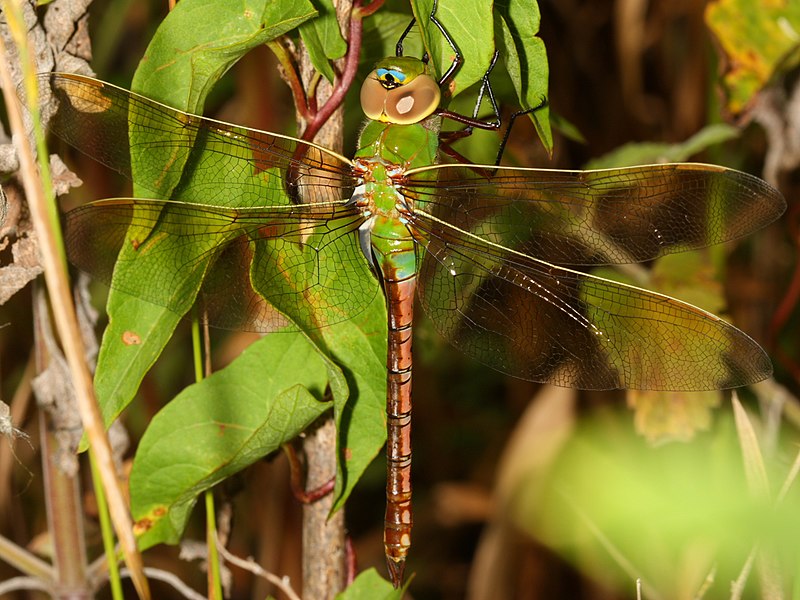Most species move only of some kilometers around their emergence spot;
however some are "pioneers" and will travel much greater distances to
colonize new reproduction sites. Dragonfly migration has not yet been
thoroughly studied and for a reason... Try to follow them on dozens of
kilometers!
It is estimated that only 25 to 50 of the 5200 world odonata species listed are migratory. What
we know it is that this phenomenon is closely tied to that of bird
migrations which follow coastlines, probably because they are a sure
source of food for insectivores. Dragonflies get ready for the migration by accumulating reserves of fat, as many of other insects and birds.
The case of the
Green darner
- Anax junius
It is one of the 9 migratory species known in the USA.
Part
only of its populations is migratory; those living in the North remain
there and reproduce locally whereas in the southern ones move northward
to reproduce and the following generation returns then southward,
travelling so several hundred kilometers each time - see detailed
explanations in Charles Anderson's brilliant video
[HERE].
They migrate exclusively by day with winds below 25 k/h, whatever these
winds' direction and only after 2 successive nights of low
temperatures.
Some years, a few individuals have been seen on Brittany’s coasts in
France, carried by high altitude winds but too weak to reproduce.
In the US, the Green darter is the object of a study with a tiny transmitter placed under the abdomen of a few insects. the results are stunning: Some manage to fly 140km / day!
The Red veined darter (Sympetrum fonscolombii) is also quite a traveller:
 |
| Red veined darter, male |
so is the Four spotted chaser (Libellula
quadrimaculata)...
and Hemianax ephippiger, 2011 being an exceptional migration year in France et of which Alain has been a witness:
Finally here is the fascinating case of the Globetrotter (Pantala flavescens), a common species in the tropical regions crossed by the equator, but the species inhabiting the countries around the Indian Ocean have a very particular migratory cycle.
These last years, Charles Anderson (see the video above mentioned), an English marine biologist who has been working in the Maldive Islands for 26 years noted the appearance of million of these dragonflies at a precise moment every year.
He asked his contacts in India if they had been noticed a similar event on the continent at the same dates... The answers confirmed his sightings! Fresh water lacking totally on the Maldive Islands, he wondered why they were flying there.
As the season turns in, they are seen almost every year precisely on September 24th in Bangalore, in October 12th in the very south of India, on October 17th in the North of the Maldive Islands, the 21octobre in Malé and finally on November 7th in the South of the archipelago. They came thus from the continent but with the northeast monsoon winds, but to go where... To the east of Africa. Anderson's contacts there confirmed the appearance of these dragonflies following the first summer rains coming toward Kenya. The Globetrotters are spot on: the females lay then in puddles and the larvae's life cycle being very short, these emerge only a few weeks later as dragonflies.
In the meantime the rains travel southerly toward the east of austral Africa and this generation will follow them to lay the next and the latter will then travel back to Kenya to lay one more generation which will fly back to India following the south-west monsoon, finalizing the cycle in 4 generations and over 16.000 km around the Indian ocean.
This is the largest insect migration known today.
These dragons are followed by the Amur Falcon the migration of which i as amazing... It extends from the Amur river in China, along the Chinese coastlines and through India, to reach the east of... austral Africa! Well yes, at the same time as the Pantala flavescens... a coincidence?
And they are not the only ones
 |
| Photo Wikipedia |
The Jacobin Cuckoo (Clamator jacobinus),
 |
| Photo Wikipedia |
and the Indian Roller (Coracias benghalensis) among many others
Noushka








✿ Un petit coucou chez toi en ce dimanche matin chère Noushka !!!
RépondreSupprimerMERCI pour ces belles photos et les infos qui sont très intéressantes.
Je t'envoie de GROS BISOUS d'Asie jusqu'à chez toi ✿
Et demain, tu nous fais la version espagnole ;-))
RépondreSupprimerAh oui, là je veux bien ;)
SupprimerBravo et merci pour le boulot ! Cdlt, M.
RépondreSupprimer